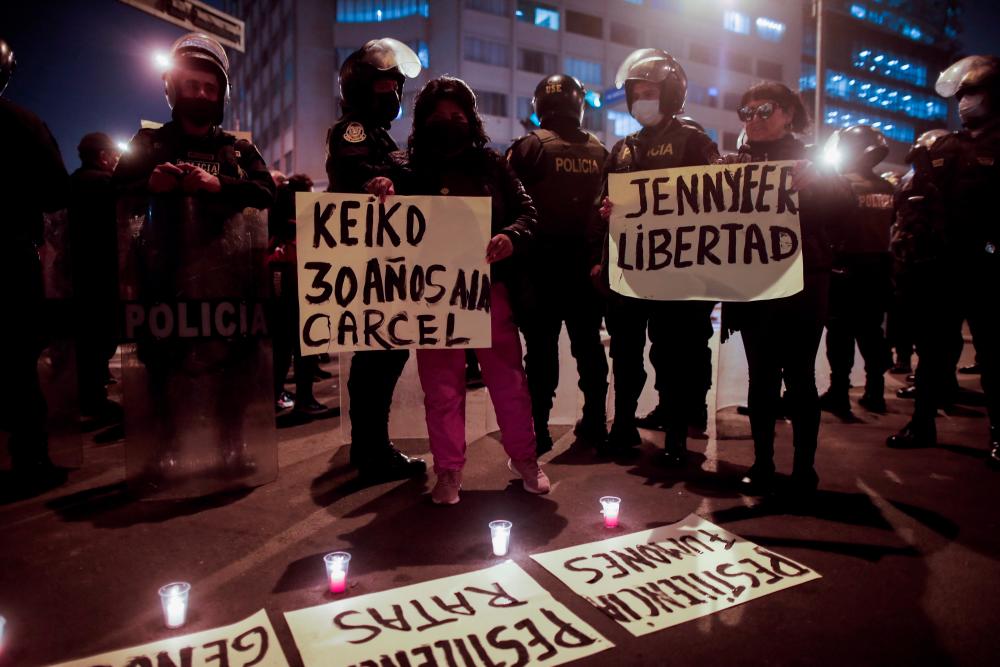International
Peru’s Castillo shakes up police leadership after raid of govt headquarters

AFP
Leftist Peruvian President Pedro Castillo replaced the leadership of the country’s national police Saturday, two weeks after anticorruption officials searched government headquarters in search of the leader’s wanted sister-in-law.
During the raid earlier this month, which Castillo has called “illegal,” investigators looked for Yenifer Paredes, who is accused of taking part in a corruption ring which prosecutors allege is run by the president and his wife, Lilia Paredes.
Among others, Castillo is now seeking to dismiss the head of that operation, Harvey Colchado, whom he says violated presidential immunity.
Deputy Internal Order Minister Abel Gamarra Saturday the turnover is a “natural change” as part of regular personnel switch-ups at the Interior Ministry.
“Norms (on appointment requirements) have not been violated,” Gamarra told RPP radio, adding that the “police command is not being crushed.”
Nevertheless, right-wing opposition lawmaker Jorge Montoya, who sits on the Internal Order parliamentary committee, on Twitter called the changes an “indiscriminate abuse of authority” by Castillo.
According to human rights lawyer Carlos Rivera Paz, Castillo “seems to want a police force that accommodates his interests,” which could include obstructing any investigations of which he is a target.
The ordeal is the second scandal Castillo has faced in regards to personnel changes at the top of Peru’s security forces.
In January, he was forced to name a new cabinet head after controversy over promotions in the Peruvian National Police (PNP) and the armed forces.
Those promotions are under investigation by prosecutors, which alleges that Castillo and former secretary of the presidency Bruno Pacheco engaged in influence peddling.
Castillo is currently the subject of an unprecedented six investigations for offenses including organized crime, obstruction of justice and plagiarism, though he carries presidential immunity through the end of his term in July 2026.
And Castillo’s family also faces legal trouble — his daughter risks three years of preliminary detention for her role in the corruption plot, while his wife could be banned from leaving the country.
Castillo, who has faced two impeachment attempts in his 13 months in office and currently has a disapproval rate around 70 percent; he has denied involvement in any crimes and claims he is a victim of a campaign trying to remove him from power.
International
Paraguay summons Brazilian ambassador over Itaipú espionage scandal

Paraguay summoned the Brazilian ambassador in Asunción on Tuesday to demand “explanations” and called its own representative in Brasília for consultations following Brazil’s acknowledgment of an espionage operation. The Brazilian government, led by President Luiz Inácio Lula da Silva, attributed the operation to the previous administration.
The surveillance effort aimed to uncover Paraguay’s position in now-suspended negotiations with Brazil regarding the pricing of electricity from the binational Itaipú hydroelectric plant, according to reports in the Brazilian press.
The Brazilian government “categorically denied any involvement in the intelligence operation,” stating in a Foreign Ministry communiqué on Monday that the espionage was carried out under former President Jair Bolsonaro’s administration (2019-2023).
“The operation was authorized by the previous government in June 2022 and was annulled by the interim director of the (state intelligence agency) ABIN on March 27, 2023, as soon as the current administration became aware of it,” Brazil’s government asserted.
Paraguay’s Foreign Minister Rubén Ramírez announced that Brazilian Ambassador José Antonio Marcondes de Carvalho was summoned “to provide detailed explanations” regarding the operation. Additionally, Paraguay recalled its diplomatic representative in Brasília “to report on aspects related to the intelligence activity conducted by Brazil regarding Paraguay’s government affairs.”
International
Elon Musk to step down as government advisor, per Trump insiders

President Donald Trump has informed his inner circle that Elon Musk will be stepping down from his role as a government advisor, according to a report by Politico today.
Citing three individuals close to Trump, Politico states that the president is pleased with Musk’s leadership at the Department of Government Efficiency (DOGE), where he has implemented significant budget cuts. However, both have agreed that it is time for Musk to return to his businesses and support Trump from a different position outside the government.
A senior administration official told Politico that Musk will likely maintain an informal advisory role and continue to be an occasional visitor to the White House. Another source warned that anyone thinking Musk will completely disappear from Trump’s circle is “deluding themselves.”
According to the sources, this transition is expected to coincide with the end of Musk’s tenure as a “special government employee,” a temporary status that exempts him from certain ethics and conflict-of-interest regulations. This 130-day period is set to expire in late May or early June.
International
Milei vows to make Argentina so strong that Falkland Islanders “choose” to join

Argentine President Javier Milei reaffirmed his country’s claim over the Falkland Islands (known as the Islas Malvinas in Argentina) and praised the role of the nation’s armed forces during a ceremony marking the “Veterans and Fallen Soldiers of the Malvinas War Day,” commemorating 43 years since the 1982 conflict with the United Kingdom.
Argentina continues to assert sovereignty over the islands, arguing that Britain unlawfully seized them in 1833.
“If sovereignty over the Malvinas is the issue, we have always made it clear that the most important vote is the one cast with one’s feet. We hope that one day, the Malvinas residents will choose to vote with their feet and join us,” Milei stated.
“That is why we aim to become a global power—so much so that they would prefer to be Argentine, making deterrence or persuasion unnecessary. This is why we have embarked on a path of liberation, working to make Argentina the freest country in the world and once again the nation with the highest GDP per capita on the planet,” he added.
-

 Central America3 days ago
Central America3 days agoU.S. Homeland Security Secretary urges Mexico to strengthen Guatemala border
-

 Central America3 days ago
Central America3 days agoPanama grants Martinelli 72-hour extension to travel to Nicaragua
-

 International2 days ago
International2 days agoParaguay summons Brazilian ambassador over Itaipú espionage scandal
-

 Central America4 days ago
Central America4 days agoPanama police clarifies that Interpol alert for Martinelli is still pending
-

 International3 days ago
International3 days agoTrump urges Putin to reach peace deal
-

 International4 days ago
International4 days agoDeportation flight lands in Venezuela; government denies criminal gang links
-

 Sports2 days ago
Sports2 days agoFilipe Luis debuts as coach in Copa Libertadores with Flamengo
-

 Central America2 days ago
Central America2 days agoGuatemalan police officer killed in mob riots over baby kidnapping
-

 International2 days ago
International2 days agoElon Musk to step down as government advisor, per Trump insiders
-

 Sports2 days ago
Sports2 days agoVenezuela investigates 18 baseball players seeking asylum in Spain
-

 International2 days ago
International2 days agoMilei vows to make Argentina so strong that Falkland Islanders “choose” to join
-

 International2 days ago
International2 days agoICE agent’s arrest of suspect sparks controversy in Boston
-

 International2 days ago
International2 days agoÓscar Arias: Trump’s trade policies are a step backward















